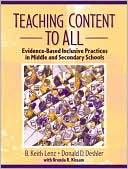List Books » Teaching Content to All: Evidence-Based Inclusive Practices in Middle and Secondary Schools
Category Books
- Fiction Books & Literature
- Graphic Novels
- Horror
- Mystery & Crime
- Poetry
- Romance Books
- Science Fiction & Fantasy
- Thrillers
- Westerns
- Ages 0-2
- Ages 3-5
- Ages 6-8
- Ages 9-12
- Teens
- Children's Books
- African Americans
- Antiques & Collectibles
- Art, Architecture & Photography
- Bibles & Bible Studies
- Biography
- Business Books
- Christianity
- Computer Books & Technology Books
- Cookbooks, Food & Wine
- Crafts & Hobbies Books
- Education & Teaching
- Engineering
- Entertainment
- Foreign Languages
- Game Books
- Gay & Lesbian
- Health Books, Diet & Fitness Books
- History
- Home & Garden
- Humor Books
- Judaism & Judaica
- Law
- Medical Books
- New Age & Spirituality
- Nonfiction
- Parenting & Family
- Pets
- Philosophy
- Political Books & Current Events Books
- Psychology & Psychotherapy
- Reference
- Religion Books
- Science & Nature
- Self Improvement
- Sex & Relationships
- Social Sciences
- Sports & Adventure
- Study Guides & Test Prep
- Travel
- True Crime
- Weddings
- Women's Studies
Teaching Content to All: Evidence-Based Inclusive Practices in Middle and Secondary Schools » (1st Edition)

Authors: B. Keith Lenz, B. Keith Lenz
ISBN-13: 9780205392247, ISBN-10: 0205392245
Format: Paperback
Publisher: Allyn & Bacon, Inc.
Date Published: May 2003
Edition: 1st Edition
Author Biography: B. Keith Lenz
Book Synopsis
This textbook for future secondary school teachers addresses academic diversity and presents strategies for planning lessons, units, and entire courses. The book also discusses teaching routines, and relates them to research on learning strategies a nd effective communication. Vignettes describe the problems that arise in actual classroom practice. The authors teach at the University of Kansas. Annotation ©2003 Book News, Inc., Portland, OR
Table of Contents
Each chapter contains “Foundations and Principles” and “Knowing and Doing” and concludes with “Summary.”
Preface.
Introduction.
I. FRAMING PEDAGOGIES FOR DIVERSITY.
1. Teaching and Academic Diversity, B. Keith Lenz and Donald D. Deshler.
2. The Challenges of Diversity, Sharon Lynch and Juliana Taymans.
Principles of Standards-Based Education Reform.
Equity and Barriers to Systemic Reform.
II. CONCEPTUALIZING PEDAGOGIES FOR ACADEMIC DIVERSITY.
3. SMARTER Planning for Academic Diversity, B. Keith Lenz, Janis A. Bulgren, Brenda R. Kissam and Juliana Taymans.
AQ: Janis A. Bulgren or Janis V. Bulgren?
Making Connections: Implementing SMARTER Planning.
III. ROUTINES FOR DESIGNING INSTRUCTION AND LEARNING.
4. Course Planning for an Academically Diverse Class. Keith Lenz, Brenda R. Kissam. and David Scanlon.
Making Connections: Implementing Course Planning.
5. Course Planning: Establishing a Classroom Learning Community, Brenda R. Kissam, B. Keith Lenz, and David Scanlon.
Making Connections: How Can I Establish a Learning Community?
6. Course Planning: Knowing Yourself and Your Students to Guide Learning, Jerome J. Ammer, Jennifer C. Platt and Jeffrey W. Cornett.
Making Connections: Implementing a Communication System.
7. Developing a Unit Planning Routine, Juliana Taymans and Sharon Lynch.
Current Education Reforms: Standards.
Assessment: Is Everyone on the Journey?
The Unit Organizer and Collaborating with Other Professionals.
Making Connections: Implementing the Unit Organizer.
8. Lesson Planning and Delivery, Lillie R. Albert and Jerome J. Ammer.
Making Connections: Implementing the Lesson Organizer Routine.
IV. TEACHING YOUR COURSE.
9. Teaching Content in an Academically Diverse Classroom, Margaret E. King-Sears and Jean F. Mooney.
Making Connections: Implementing Content Enhancement.
10. Teaching Learning Strategies, Gwen Berry, Deborah Hall, and Patricia G. Gildroy.
Making Connections: Teaching Learning Strategies in the Regular Education Classroom.
V. INCLUSION AND SPECIAL EDUCATION.
11. Special Education Policies and Procedures, Earle Knowlton.
Making Connections: Special Education Policies and Procedures.
12. Linking to Other Professionals, Suzanne M. Robinson.
Making Connections: Linking to Other Professionals in Secondary Schools.
Conclusion—Models of Integrated Organizers.
Putting It All Together.
Appendix A. Learner-Centered Principles of the AmericanPsychological Association: A Framework for School Redesign and Reform.
Appendix B. Using SMARTER to Enhance Instruction, (Margaret E. King-Sears and Jean F. Mooney).
Appendix C. The Strategic Instruction Model (SIM).
Appendix D. Checklist for Considerate Text Characteristics.
TRIMS: Strategies for Enhancing Text Problem Areas.
Glossary.
Index.
Subjects
 Educational Levels & Settings
Educational Levels & Settings  Middle School Education
Middle School EducationEducation & Teaching
 Educational Theory, Research & History
Educational Theory, Research & History  Educational Reform
Educational ReformEducation & Teaching
 Middle School Education
Middle School Education  Middle school education -> Curricula -> United States
Middle school education -> Curricula -> United StatesEducation & Teaching
 Special Education
Special Education  Educational Program Components
Educational Program Components
